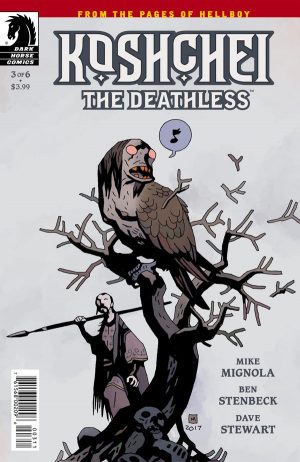 I’ve read a lot of comics in my day, everything from light-hearted romance manga to the ultra-gore that is Garth Ennis’s Crossed, but there have been only handful of times when I closed the work and audibly said “now THAT was a good comic!” Most of them were handed out cautiously and most certainly after checking every nook and cranny for writing and artwork flaws, poor ebb and flow, and the dreaded ‘talking head’ syndrome, so it’s with no light-hearted rhetoric that I use that phrase. It’s with all confidence that I say that Koshchei the Deathless is a good comic. Written by Mike Mignola and heavily referenced from Slavic folklore, Koshschei the Deathless tells the story of one of Hellboy’s most formidable foes and how he became the slave to the infamous Baba Yaga.
I’ve read a lot of comics in my day, everything from light-hearted romance manga to the ultra-gore that is Garth Ennis’s Crossed, but there have been only handful of times when I closed the work and audibly said “now THAT was a good comic!” Most of them were handed out cautiously and most certainly after checking every nook and cranny for writing and artwork flaws, poor ebb and flow, and the dreaded ‘talking head’ syndrome, so it’s with no light-hearted rhetoric that I use that phrase. It’s with all confidence that I say that Koshchei the Deathless is a good comic. Written by Mike Mignola and heavily referenced from Slavic folklore, Koshschei the Deathless tells the story of one of Hellboy’s most formidable foes and how he became the slave to the infamous Baba Yaga.
The comic is centered in the middle of the Hellboy in Hell story arc, as Hellboy takes a break from fighting his destiny to meet with his old nemesis Koshchei in a bar somewhere on the shores of Hell’s ocean. What starts as a meeting between two dead foes, long tired from fighting each other, soon turns into Koshchei telling his companion his life story; and boy oh boy, is it a hell of a life. Born to common parents, Koshchei quickly climbs the ranks of army life before being left for dead by his own soldiers. Luckily, a dragon happened to be passing by and rescued him. For nine years, he toiled away as the dragon’s servant before being set free with a magical shirt that protected him from death. Unfortunately, not everyone was happy with his return and after learning that his shirt kept him alive, he was stripped and killed, and once again back in the possession of the dragon, who this time grants him immortality as long as he hides his soul away. Too bad that Baba Yaga has some devious plans for him. And this is just the first few pages!
There’s so much that happens in this comic. We’re talking monsters, witches, romance, dragons, the Baba Yaga, and of course, Hellboy himself. This is a solid life to death account of Koshchei that follows our protagonist as his adventures intertwine with common themes of Slavic folklore. That’s to say, there’s a lot strange tasks and treasures hidden within other things and lessons that everyone was learning except him. That’s really the meat behind the comic; the humanity that ebbs and flows through Koshchei’s body as his predicaments shape the man he becomes. He goes from rich to poor, powerful to powerless, all the while making choices that had a lasting effect on everyone around him, and not all the choices are good. Even in Hell, Koshchei reflects on his past actions and still can’t decide if what he did when he was alive was the right thing to do (which is probably the real point of Hell). All in all, there’s a shadow of doubt throughout the whole work that begs the question: what would you do in his same situation? The comic is just as much as a testament to the choices we make as it is a monster-punching good time.
Now, in case you have never read my name, I am definitely Russian and a lot of the themes and ideas that Mignola presents in the comic are very accurate to Slavic folklore, yet, much like folklore from anywhere in the world, it’s very accessible. He addresses many themes, themes that are prevalent in all cultures (love, death, greed, ect), and filters them through something we all love, a Hellboy story. Hellboy is the great folklore equalizer: a sympathetic demon, also known as man. You almost can’t help but love this comic, you are Koshchei’s drinking guest after all. The accompanying art is also just as fantastic. Handled by Ben Stenbeck, the illustrations are just similar enough to Mignola’s original pen work but, but handling the inking and line thickness differently, stand out on their own. The angles, the colors, the detail work are all a great companion to Mignola’s writing and the two blend seamlessly together to make for a visual wonderland. With coloring by Mignola’s longtime partner David Stewart, the overall package is as appealing from the first page as it to the last.
If you’re a fan of literally anything, comics, folklore, Hellboy, monsters, I highly, HIGHLY recommend you pick up Koshchei the Deathless. It is a perfect, one story-arc work, that’ll leave you just as stunned as I was. The graphic novel is out now on shelves everywhere!
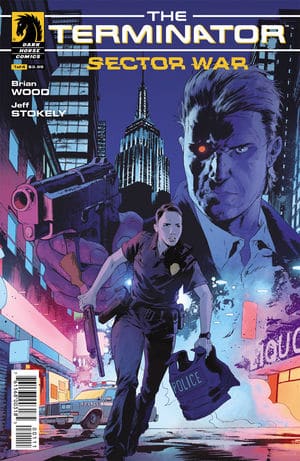 The comic starts off with our lead Lucy Castro, a down-on-her-luck cop whose life isn’t exactly amazing. Assigned to the worst area in LA and living with a narcissistic, abusive boyfriend to boot, Lucy can’t imagine her life could get any worse. But this is a Terminator comic, so it’s going to get a whole lot worse. Hot on her heels is a T-800, who, not known for its subtlety, begins hunting her down by tearing his way through her building and tossing her boyfriend down a stairwell. This starts a chase through the back alleys of LA as Lucy attempts to put some space between the T-800 and herself while trying to figure out what exactly is going on, which leads to some startling revelations of her own.
The comic starts off with our lead Lucy Castro, a down-on-her-luck cop whose life isn’t exactly amazing. Assigned to the worst area in LA and living with a narcissistic, abusive boyfriend to boot, Lucy can’t imagine her life could get any worse. But this is a Terminator comic, so it’s going to get a whole lot worse. Hot on her heels is a T-800, who, not known for its subtlety, begins hunting her down by tearing his way through her building and tossing her boyfriend down a stairwell. This starts a chase through the back alleys of LA as Lucy attempts to put some space between the T-800 and herself while trying to figure out what exactly is going on, which leads to some startling revelations of her own. 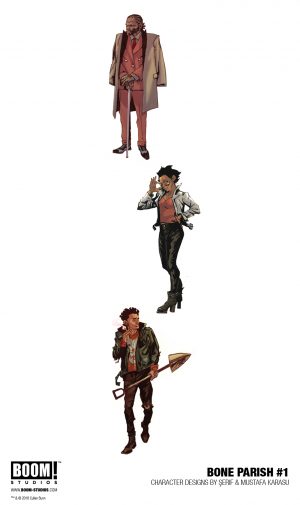 Bone Parish, as stated, is about drugs. But not just any drugs, a drug that’ll get you ripped out of your freaking skull! No one quite knows what’s in it, but they do know that’s it’s expensive as hell and only a very few people supply it; those people being Mama Grace and her family. You see, the real secret is that the drugs are actually made out of the ashes of dead people and those dead people have made the family very rich, which also means plenty of conflicts on how the business should be run, both from within and outside the family. When a high roller from NYC comes to visit Mama’s home base in New Orleans to offer to buy her company, she firmly says no, knowing that she hasn’t seen the last of him. Suddenly, things around her begin to spin out of control as both the drug and the business begins to turn against her plans.
Bone Parish, as stated, is about drugs. But not just any drugs, a drug that’ll get you ripped out of your freaking skull! No one quite knows what’s in it, but they do know that’s it’s expensive as hell and only a very few people supply it; those people being Mama Grace and her family. You see, the real secret is that the drugs are actually made out of the ashes of dead people and those dead people have made the family very rich, which also means plenty of conflicts on how the business should be run, both from within and outside the family. When a high roller from NYC comes to visit Mama’s home base in New Orleans to offer to buy her company, she firmly says no, knowing that she hasn’t seen the last of him. Suddenly, things around her begin to spin out of control as both the drug and the business begins to turn against her plans. 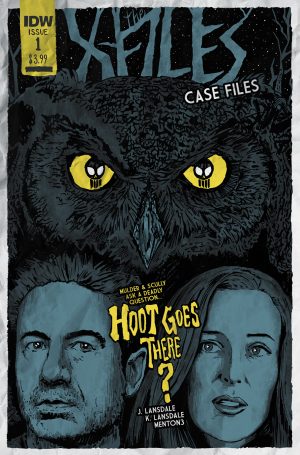 You know what’s great about the X-Files? Everything! Everything is great about the X-Files! It’s a goddamn national treasure right up there with the White House and that soup painting by Andy Warhol. The political intrigue of a secret FBI unit, the moral intricacies of discovering a world beyond our understanding, ALIENS! It’s got everything a good show needs so it’s no wonder that years after its demise (and a couple mini-arcs) the X-Files fandom is still going strong; cumulating into a huge expanded universe via comics. X-Files Case Files is yet another welcome addition to the comic world, albeit a bit more low-key than usual, as it sends everyone’s favorite G-Men to Texas to hunt a giant owl. A wonderful little story that explores the backwoods of Americana, Hoot Goes There will remind you why Mulder and Scully are the perfect pair to tackle the weird and wild.
You know what’s great about the X-Files? Everything! Everything is great about the X-Files! It’s a goddamn national treasure right up there with the White House and that soup painting by Andy Warhol. The political intrigue of a secret FBI unit, the moral intricacies of discovering a world beyond our understanding, ALIENS! It’s got everything a good show needs so it’s no wonder that years after its demise (and a couple mini-arcs) the X-Files fandom is still going strong; cumulating into a huge expanded universe via comics. X-Files Case Files is yet another welcome addition to the comic world, albeit a bit more low-key than usual, as it sends everyone’s favorite G-Men to Texas to hunt a giant owl. A wonderful little story that explores the backwoods of Americana, Hoot Goes There will remind you why Mulder and Scully are the perfect pair to tackle the weird and wild.  When most people think of literary witches, they imagine either a crooked-nosed old hag or a cat-eyed seductress intent on taking your virgin blood. Either way, they are generally written as mischievous or evil women that get their powers from demons. But aside from a few exceptions, it wasn’t until Japan mashed witches with magical girls that the narrative for these sorceresses really changed. Having been unburdened by centuries of Western beliefs, they took what was supposed to be a bogeywoman and turned her into a powerful feminine creature that was gentle to the earth and a frequent purveyor of the healing arts. With help from Japan’s long history of natural religion and a fondness for shrine maidens, the lore of the fictional Japanese witch became ripe with positivity, and downright cute! The anime Flying Witch is no exception.
When most people think of literary witches, they imagine either a crooked-nosed old hag or a cat-eyed seductress intent on taking your virgin blood. Either way, they are generally written as mischievous or evil women that get their powers from demons. But aside from a few exceptions, it wasn’t until Japan mashed witches with magical girls that the narrative for these sorceresses really changed. Having been unburdened by centuries of Western beliefs, they took what was supposed to be a bogeywoman and turned her into a powerful feminine creature that was gentle to the earth and a frequent purveyor of the healing arts. With help from Japan’s long history of natural religion and a fondness for shrine maidens, the lore of the fictional Japanese witch became ripe with positivity, and downright cute! The anime Flying Witch is no exception.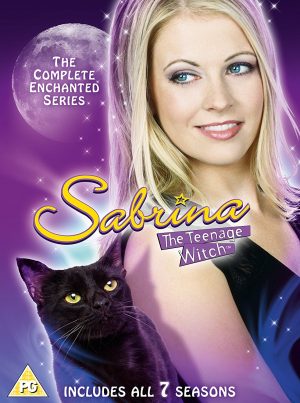 Do you remember that brief time in the nineties when Melissa Joan Hart was the Queen of teen? With her fashion forward outfits and sharp take on teen/tween issues, she became an unofficial icon of young girls in ugly overalls everywhere, taking her unique brand of YOU-nique across the after-school TV plateau spanning from Clarissa Explains it All to Sabrina the Teenage Witch. Unfortunately, I’m not here to praise the wonders that is Her Royal Majesty Queen Hart, but instead to explore the in-and-outs of that magic, boy-obsessed wonder girl that is Sabrina. While Hart may have revived her for the nineties kids market, Sabrina has a long history in TV, print media, and, most importantly, comic books.
Do you remember that brief time in the nineties when Melissa Joan Hart was the Queen of teen? With her fashion forward outfits and sharp take on teen/tween issues, she became an unofficial icon of young girls in ugly overalls everywhere, taking her unique brand of YOU-nique across the after-school TV plateau spanning from Clarissa Explains it All to Sabrina the Teenage Witch. Unfortunately, I’m not here to praise the wonders that is Her Royal Majesty Queen Hart, but instead to explore the in-and-outs of that magic, boy-obsessed wonder girl that is Sabrina. While Hart may have revived her for the nineties kids market, Sabrina has a long history in TV, print media, and, most importantly, comic books.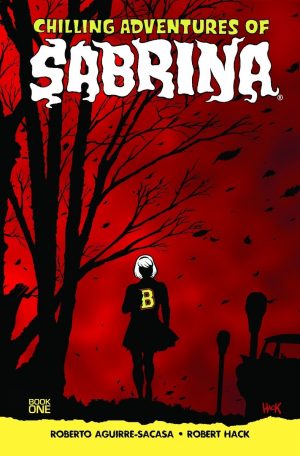 Sabrina’s most recent (though currently on hiatus) incarnation is entitled the Chilling Adventures of Sabrina, a dark reimagining of Sabrina’s powers and the witches as a whole. A TV show based on this comic is currently in the works and is rumored to be released later this year via Netflix. Having read the comic myself, I can assure you that if the show is true to the source material, shit’s gonna get real dark, real fast.
Sabrina’s most recent (though currently on hiatus) incarnation is entitled the Chilling Adventures of Sabrina, a dark reimagining of Sabrina’s powers and the witches as a whole. A TV show based on this comic is currently in the works and is rumored to be released later this year via Netflix. Having read the comic myself, I can assure you that if the show is true to the source material, shit’s gonna get real dark, real fast.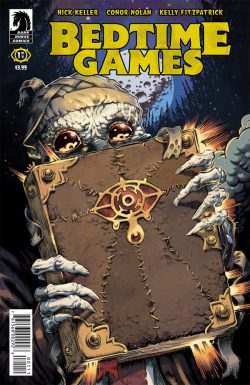 The comic focuses on three high school kids who are about to enter their senior year. With their last summer of freedom setting behind them, they decide to end the season with an exploration of an underground tunnel that connects the school to the park. As they each decide if they want to go in, the comic cuts with flashbacks of the kid’s lives. Avery is haunted by the sudden murder of her mother, Owen by his brother’s disease, and Jaime by his ever-growing hatred for his father. These narratives soon intertwine into their lives, requiring the immediate release of spontaneity for them to forget, which naturally leads to the tunnel. But what exactly lies in the tunnel and why did the last kid who went in there die? The only way to find out is to solve the riddle of the Mr. Bedtime but he seems to have plans of his own.
The comic focuses on three high school kids who are about to enter their senior year. With their last summer of freedom setting behind them, they decide to end the season with an exploration of an underground tunnel that connects the school to the park. As they each decide if they want to go in, the comic cuts with flashbacks of the kid’s lives. Avery is haunted by the sudden murder of her mother, Owen by his brother’s disease, and Jaime by his ever-growing hatred for his father. These narratives soon intertwine into their lives, requiring the immediate release of spontaneity for them to forget, which naturally leads to the tunnel. But what exactly lies in the tunnel and why did the last kid who went in there die? The only way to find out is to solve the riddle of the Mr. Bedtime but he seems to have plans of his own. 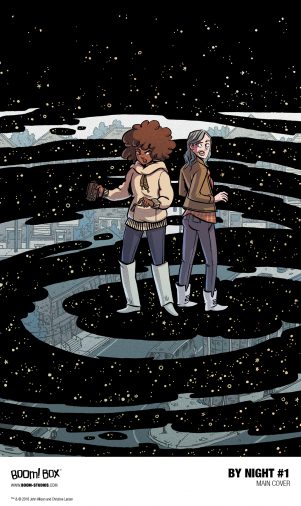
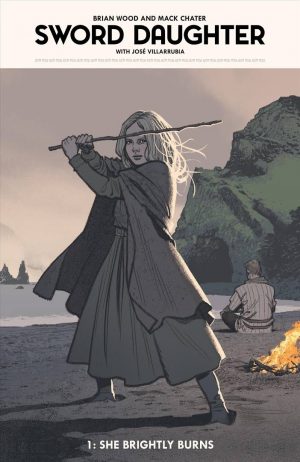 You know what’s cool? Vikings. You know what else is cool? Samurai. You know what’s the coolest thing ever then? Yup, Vikings fighting Samurai. And no, I’m not talking about that Cowboy Ninja Viking comic from nine years ago about a dude with a split personality (which will be a movie in 2019), but a legit Vikings fighting Samurai comic. Helmed by Brian Wood, the powerhouse behind the Viking epic Northlanders, Sword Daughter follows the life of a father-daughter team as they hunt down those that are responsible for burning down their village. But this isn’t another Lone Wolf and Cub scenario; this dog and puppy don’t exactly see eye-to-eye and clash with each other as much as they clash with their enemies. A tale of family, blood, and spectacular revenge, Dark Horse Comics’ latest work writes a poignant tale of blood that’s not always thicker than water and the lengths one goes to set things right.
You know what’s cool? Vikings. You know what else is cool? Samurai. You know what’s the coolest thing ever then? Yup, Vikings fighting Samurai. And no, I’m not talking about that Cowboy Ninja Viking comic from nine years ago about a dude with a split personality (which will be a movie in 2019), but a legit Vikings fighting Samurai comic. Helmed by Brian Wood, the powerhouse behind the Viking epic Northlanders, Sword Daughter follows the life of a father-daughter team as they hunt down those that are responsible for burning down their village. But this isn’t another Lone Wolf and Cub scenario; this dog and puppy don’t exactly see eye-to-eye and clash with each other as much as they clash with their enemies. A tale of family, blood, and spectacular revenge, Dark Horse Comics’ latest work writes a poignant tale of blood that’s not always thicker than water and the lengths one goes to set things right.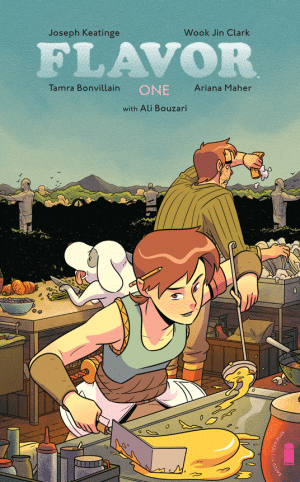 Issue one starts off with a ton of exposition and helps set up Xoo’s world, which there is a lot of. From the swarms of chefs, to the police, to the delicate situation of Xoo’s parents, there is a lot that needs to be explained before the comic can really dive into the story. That being said, the comic handles the exposition beautifully. The writer Joseph Keatinge smartly dodges the ‘talking head’ syndrome and instead handles most of the introductory story through action. Characters are constantly grabbing things or walking through the luscious scenery, giving a very natural feeling to everyone’s interactions. They move while they talk and react to the actions around them which is very hard to pull off in comic medium. Too many comics rely on the reader to fill in the blanks of subtle movement when characters talk, but this one actually does it. It’s kind of like watching a well-done cartoon or, as mentioned, a Miyazaki film. The work really seems alive, it’s wonderful.
Issue one starts off with a ton of exposition and helps set up Xoo’s world, which there is a lot of. From the swarms of chefs, to the police, to the delicate situation of Xoo’s parents, there is a lot that needs to be explained before the comic can really dive into the story. That being said, the comic handles the exposition beautifully. The writer Joseph Keatinge smartly dodges the ‘talking head’ syndrome and instead handles most of the introductory story through action. Characters are constantly grabbing things or walking through the luscious scenery, giving a very natural feeling to everyone’s interactions. They move while they talk and react to the actions around them which is very hard to pull off in comic medium. Too many comics rely on the reader to fill in the blanks of subtle movement when characters talk, but this one actually does it. It’s kind of like watching a well-done cartoon or, as mentioned, a Miyazaki film. The work really seems alive, it’s wonderful.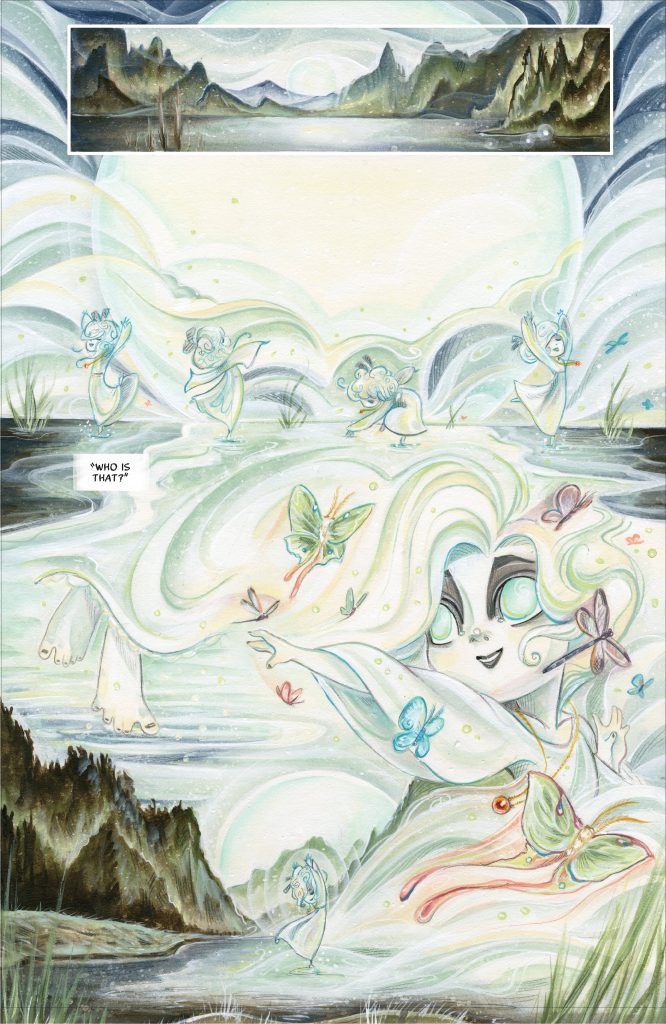 You ever catch your dog staring aggressively into a corner of your house or your cat batting around an invisible ball? Spoiler alert: you’ve got ghosts. Between you and your pet stands centuries of ghostly entities ready to rip you to shreds, if wasn’t for ol’ Rover keeping them in check. You may not believe it, but for millennia, animals have been thought to be more finely in tune than us with the supernatural world and some are even rumored to foreshadow death simply by hanging out outside your bedroom. In Action Comics’ The Ghost, The Owl, we get an in-depth view of one of these creatures with “the sight” as an owl helps a lost ghost remember who she was. Wonderfully illustrated, this dark fairy tale swirls in and out of the pages, but ends up promising more than it can deliver with its more style-than-substance approach. If you ever wanted some watered down Gaiman, this is the book for you.
You ever catch your dog staring aggressively into a corner of your house or your cat batting around an invisible ball? Spoiler alert: you’ve got ghosts. Between you and your pet stands centuries of ghostly entities ready to rip you to shreds, if wasn’t for ol’ Rover keeping them in check. You may not believe it, but for millennia, animals have been thought to be more finely in tune than us with the supernatural world and some are even rumored to foreshadow death simply by hanging out outside your bedroom. In Action Comics’ The Ghost, The Owl, we get an in-depth view of one of these creatures with “the sight” as an owl helps a lost ghost remember who she was. Wonderfully illustrated, this dark fairy tale swirls in and out of the pages, but ends up promising more than it can deliver with its more style-than-substance approach. If you ever wanted some watered down Gaiman, this is the book for you.